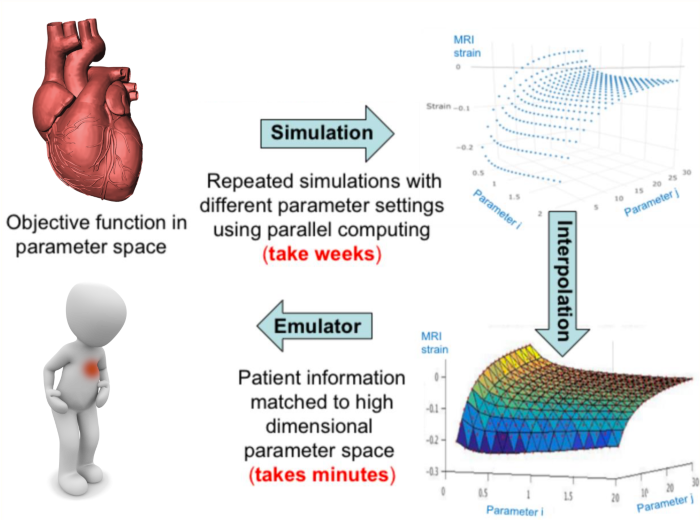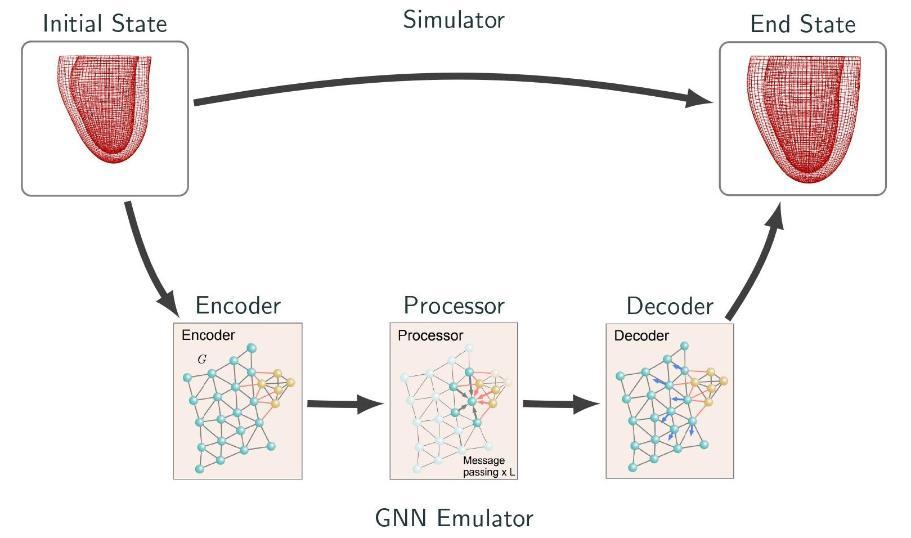Statistical Emulation in Cardiac Mechanics

Soft-tissue mechanical modelling in cardiovascular physiology is a topical research area, but a major challenge is to infer the biophysical parameters that determine the mechanical properties of the tissues and fibres non-invasively from magnetic resonance images (MRI). In principle this is achieved by comparing strains extracted from the MRI scans with those predicted from the mathematical model, and applying multivariate optimisation algorithms to find the parameters that minimise this mismatch. Unfortunately, this method does not immediately lead to a decision support tool for the clinical practice. The reason is that the soft-tissue mechanical equations have no closed-form solution and require a numerical procedure based on finite-element discretisation, which is computationally expensive. This procedure has to be repeated hundreds of times during the numerical optimisation, leading to computer run times of several weeks even on a high-performance cluster.
To deal with the high computational complexity and make progress towards a clinical decision support system that can make predictions in real time, we carry out research on statistical emulation. The idea is to approximate the computationally expensive mathematical model (the simulator) with a computationally cheap statistical surrogate model (the emulator) by a combination of massive parallelisation and nonlinear regression. Starting from some appropriate design in parameter space, the underlying partial differential equations are solved numerically with finite element discretisation on a parallel computer cluster, and methods from nonparametric Bayesian statistics based on Gaussian Processes are applied for multivariate smooth interpolation. When new data become available, e.g. in the form of MRI scans, the resulting proxy objective function can be minimised at low computational costs, without the need for any further computationally expensive simulations from the original mathematical model.
We have shown how cardio-mechanic parameter inference can be improved substantially by systematically incorporating into our emulator prior knowledge from population-wide ex-vivo volume-pressure data (see Lazarus et al. 2022).
We are currently working on a new emulation framework based on graph neural network. This is illustrated in the following figure below. We represent the left ventricle of the heart with a finite element mesh. Each node of the finite element mesh is mapped with a deep neural network to an abstract state space (the "encoder"). We use established message passing algorithms from machine learning to update the positions of the nodes in this state space, and then map them back into physical space with another deep neural network (the "decoder"). In this way we can accurately model the heart's kinematics at much higher computational speed than when numerically solving the cardiac mechanics equations. This novel emulation framework promises to directly emulate the left ventricle's high-dimensional displacement field, which wouldn't be feasible with more traditional emulation methods. For further details, see Dalton et al. (2021).


Researchers
Publications
- Improving cardio-mechanic inference by combining in vivo strain data with ex vivo volume-pressure data, Journal of the Royal Statistical Society: Series C (2022).
- Graph Neural Network Emulation of Cardiac Mechanics, 3rd International Conference on Statistics: Theory and Applications (ICSTA'21) (2021).
- Gaussian process emulation to accelerate parameter estimation in a mechanical model of the left ventricle: a critical step towards clinical end-user relevance, Journal of the Royal Society Interface, 16 (156) (2019).
- Fast parameter inference in a biomechanical model of the left ventricle by using statistical emulation, Journal of the Royal Statistical Society, Series C, 68 (5) (2019).
Organisations

